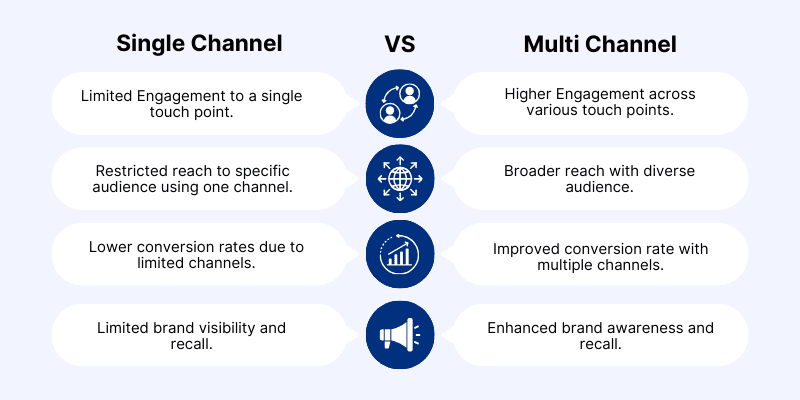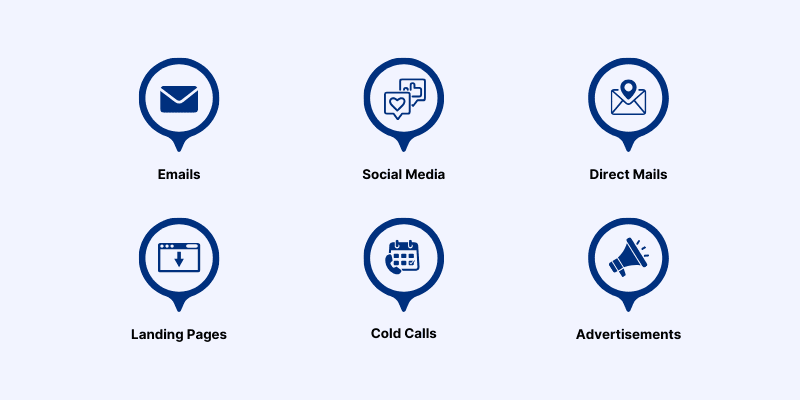Imagine reaching your audience exactly where they are, at the right time, with the right message. That’s the magic of a winning multi-channel outbound sales campaign. It’s not just about sending messages but creating connections that matter.
- Did you know businesses using multi-channel strategies retain 89% of their customers, compared to just 33% for those who stick to one channel?
- Or that companies combining multiple platforms see 166% higher engagement rates?
These numbers tell a story; one of success, impact, and incredible opportunities.
Let’s look at some real-world victories:
- Nike’s Direct-to-Consumer Push: Nike saw a 30% growth in direct-to-consumer sales by integrating their app, email, and physical stores to create an unmatched customer experience.
- Starbucks Rewards Program: With personalized offers and easy mobile access, Starbucks increased active members by 12%, boosting mobile transactions.
Now think about this: What if your business could create that kind of buzz? What if you could engage customers through email, social media, SMS, and even direct mail?
It’s not just for big brands. Small and medium businesses can also shine with the right strategy. Let’s explore how you can craft a campaign that grabs attention, builds trust, and drives results. Because your audience isn’t waiting; they’re ready.
Are you?
What is a Multi-Channel Outbound Sales Campaign?

A multi-channel outbound sales campaign integrates various communication platforms to target potential customers. It’s about engaging them across the channels they already use. This approach enhances visibility, builds trust, and boosts conversion rates.
Why Multi-Channel Campaigns Win
- Flexibility: Connect with prospects on their preferred platform.
- Increased Reach: Tap into diverse customer bases.
- Higher ROI: Combine high-impact strategies for better results.
Understanding the Core Components
1. Target Audience
You can’t sell effectively without knowing who you’re targeting. Build detailed customer personas by analyzing:
- Demographics: Age, gender, location, income.
- Psychographics: Interests, values, pain points.
- Behavior: Purchase history, online activity, and communication preferences.
2. Channel Selection
Choosing the right channels is critical. Consider these:
- Email: Ideal for personalized pitches and nurturing leads.
- Social Media: Best for brand visibility and engaging younger audiences.
- Phone Calls: Effective for closing high-ticket sales.
- Direct Mail: A unique touch in the digital age.
- SMS: Great for urgent promotions and updates.
3. Consistent Messaging
Your message should reflect your brand identity across all channels. Whether it’s a LinkedIn post or a cold email, consistency builds trust and recognition.
4. Budget Allocation
- High-budget channels like TV ads are better for brand awareness for outbound sales agencies.
- Cost-effective channels like email and SMS work well for targeting warm leads.
Steps to Develop a Winning Campaign

Step 1: Research and Data CollectionStep 1: Research and Data Collection
Before crafting your campaign, understand your market. This isn’t just about numbers; it’s about people; their needs, challenges, and desires.
- Analyze competitors: Study successful campaigns. What platforms do they use? What message resonates with their audience?
- Use tools like Google Analytics and HubSpot: Find out what channels drive traffic, and which ones underperform.
- Leverage audience insights: Use surveys, polls, and focus groups to learn what your prospects care about. Ask questions like, “What frustrates you most about [problem your product solves]?”
- Example: A clothing brand targeting eco-conscious millennials might discover that sustainability certifications and behind-the-scenes production stories drive engagement.
The more you know, the better you can tailor your message.
Step 2: Build a Unified Outbound Sales Strategy
Every successful campaign starts with clear goals and a roadmap.
Define your goals:
- Increase qualified leads by 25% within three months.
- Boost email conversion rates by 15%.
- Shorten the sales cycle by 10%.
Set KPIs for each platform:
Track metrics like email open rates, social media engagement, and conversion rates.
Unify your strategy:
- Identify which platforms your audience prefers. For instance, LinkedIn works better for B2B audiences, while Instagram suits younger, lifestyle-oriented consumers.
- Ensure all channels work together seamlessly. A cold email should lead to a landing page that mirrors its tone and message.
Pro tip: Keep the customer journey smooth. Don’t make prospects jump through hoops. Every click should feel intuitive.
Step 3: Create Compelling Content
Your content is the heart of your campaign. It grabs attention, sparks interest, and nudges prospects to take action.
- Adapt your message for each channel:
- Emails: Write personalized subject lines like, “Sarah, here’s how we can simplify your workload.”
- Social media: Use relatable memes, customer success stories, or short, inspiring videos. Example: A fitness brand could share a “before and after” journey.
- Cold calls: Open with empathy. “I know you’re busy, but I believe we can help with [specific problem].”
- Appeal to emotions:
- Share relatable pain points. “We know how frustrating it is to spend hours on a task that should take minutes.”
- Highlight aspirations. “Imagine cutting your workload in half and having more time to focus on what matters most.”
- Use visuals to amplify impact:
- Eye-catching infographics for data-heavy platforms.
- High-quality photos or videos for visual channels like Instagram.
Step 4: Test and Launch
Even the best plans need refining. Testing helps you understand what clicks and what doesn’t.
- Start small: Launch a pilot campaign targeting a small, specific audience segment.
- Run A/B tests:
- Experiment with different subject lines in emails.
- Test two ad creatives on social media to see which resonates more.
- Try varied calls-to-action (CTAs) on landing pages. For instance, “Get Started Now” vs. “Claim Your Free Trial.”
- Monitor and adjust:
- If an ad underperforms, tweak the headline or visuals.
- If an email has low open rates, rework the subject line to make it more engaging.
Example: A SaaS company tested two CTAs on its demo page. “Schedule Your Demo Today” increased sign-ups by 20% compared to “Learn More.”
Case Studies of Success
1. HubSpot’s Multi-Channel Success
HubSpot combined outbound sales strategies with a multi-channel approach, using emails, social media, and retargeting ads. The result? A 2x increase in qualified leads within six months.
2. Amazon’s Retargeting Strategy
Amazon uses email and social media ads to remind users about abandoned carts. This strategy contributes to their 35% revenue growth from retargeting alone.
3. Airbnb’s Direct Engagement Approach
Airbnb combines personalized emails, SMS updates, and social media to engage both hosts and guests. Their outbound sales efforts directly resulted in a 20% increase in bookings.
Overcoming Challenges
1. Channel Overload
Using too many platforms can dilute your message.
Solution: Focus on the 2-3 channels where your target audience is most active.
2. Measuring Success
Tracking ROI across multiple platforms is tricky.
Solution: Use unified analytics tools like Salesforce or HubSpot.
3. Consistency Issues
Inconsistent messaging across platforms can confuse prospects.
Solution: Create a comprehensive content calendar and brand voice guidelines.
4. Compliance Risks
Navigating privacy laws like GDPR and CAN-SPAM is essential.
Solution: Always get consent and include opt-out options in your communications.
Best Practices for a Winning Campaign
- Be Personal: Address prospects by name and reference past interactions.
- Automate Where Possible: Tools like Marketo streamline workflows and save time.
- Leverage Retargeting: Show social media ads to users who visited your website but didn’t convert.
- Optimize Timing: Send emails during peak hours, like 10 a.m. on weekdays.
Emerging Trends in Multi-Channel Sales
1. AI and Predictive Analytics
Artificial Intelligence (AI) has revolutionized outbound sales strategies, making campaigns smarter and more efficient. AI tools collect and analyze vast amounts of customer data to predict buying patterns, preferences, and behaviors.
How it works:
- AI algorithms monitor user interactions, such as website visits, email clicks, and social media activity.
- Based on this data, AI identifies high-potential leads and recommends the most effective outreach strategies.
- Predictive analytics prioritizes these leads, helping sales teams focus on prospects most likely to convert.
Example:
Netflix uses predictive analytics to recommend shows and movies based on viewing history and preferences. This personalized approach has boosted user engagement by 80%, proving the immense potential of AI in creating tailored customer experiences.
How businesses can benefit:
- Automate lead scoring and segmentation.
- Use AI-powered chatbots for real-time customer support.
- Implement tools like Salesforce Einstein or HubSpot AI for data-driven decision-making.
2. Voice Search
With the rise of smart devices, voice search is becoming a dominant force in how people find information. A whopping 71% of consumers rely on voice assistants like Siri, Alexa, and Google Assistant for day-to-day queries.
Why it matters for outbound sales:
- Voice search is reshaping SEO strategies. Businesses must optimize their content for conversational queries, which are longer and more specific than text-based searches.
- Consumers using voice search often have high intent, making them prime targets for tailored outbound campaigns.
Example:
A potential customer might ask their voice assistant, “Where can I find the best outbound sales agency?” If your content is optimized for voice search, your business could be the first result they hear.
Actionable tips for businesses:
- Use natural language in your content to align with how people speak.
- Focus on long-tail keywords and question-based phrases like “How can I improve my outbound sales strategy?”
- Create content that answers common queries in your niche, increasing your visibility on voice-enabled searches.
3. Interactive Content
Interactive content is not just eye-catching; it’s engaging, memorable, and highly effective in driving action. This includes polls, quizzes, live videos, and gamified experiences that encourage users to participate actively.
Why it works:
- People retain 90% of what they actively engage with, compared to just 10% of what they read.
- Interactive elements foster a two-way dialogue, making prospects feel more involved and valued.
Examples of successful interactive content:
- Instagram Stories: Businesses use polls, quizzes, and “ask me anything” features to interact with their audience. These interactive elements have been shown to boost engagement rates by 50%.
- BuzzFeed Quizzes: These viral quizzes encourage users to share their results, increasing brand visibility and traffic.
How to implement it in outbound sales:
- Create personalized quizzes that help prospects identify their needs, such as “What’s Your Ideal Outbound Sales Strategy?”
- Use live videos to showcase behind-the-scenes processes or answer FAQs in real time.
- Incorporate gamified incentives, like spin-to-win offers, to engage users on your website or email campaigns.
4. AR/VR Integration
Augmented Reality (AR) and Virtual Reality (VR) are transforming how customers interact with products and services. By offering immersive experiences, AR/VR enables businesses to bridge the gap between physical and digital sales environments.
Key Takeaways
Building a winning multi-channel campaign isn’t about adding more platforms. It’s about using the right ones strategically.
- Know your audience.
- Craft consistent, engaging content.
- Test, analyze, and refine constantly.
A Final Word
Your audience is out there, scrolling, searching, and exploring across channels. It’s your turn to meet them where they are. Use these strategies, and you’ll turn your campaign into a success story.



